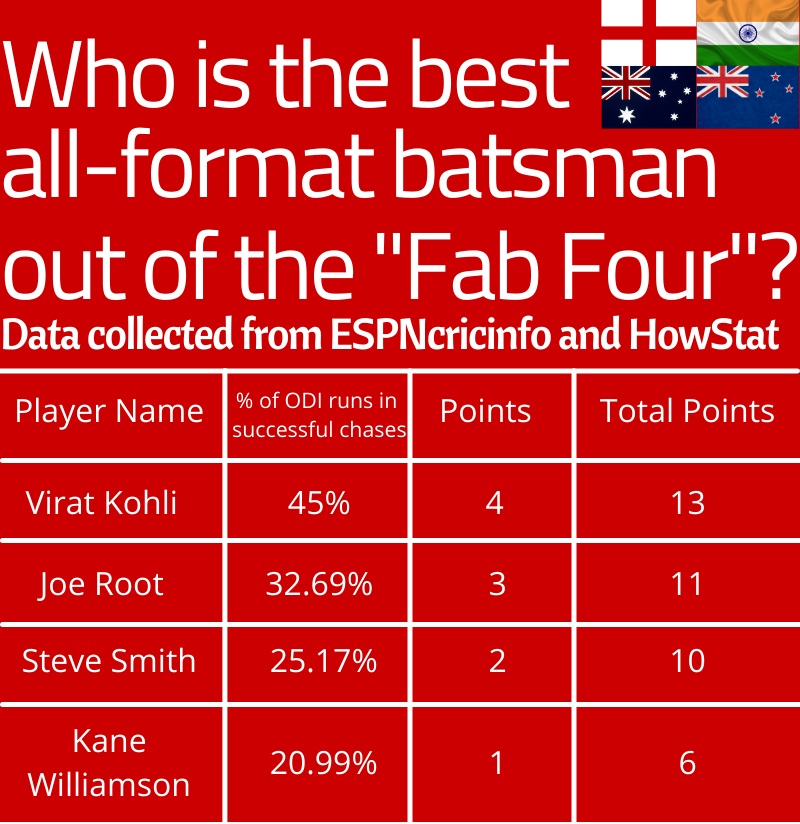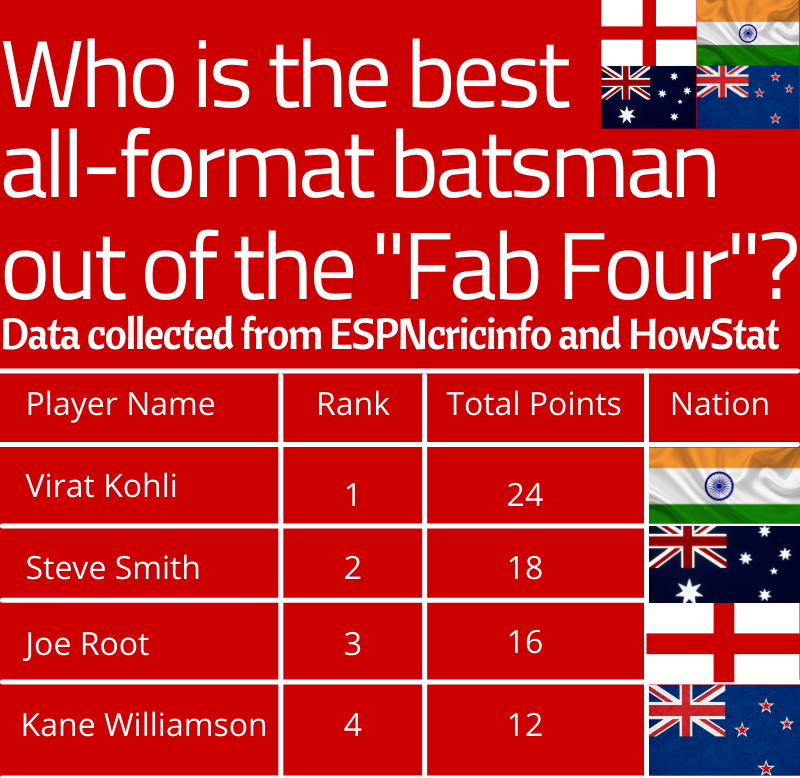Written by Riley Taylor (@rileyttaylor21)
No matter the era, there is always a debate in cricket about who is the best batsman in the world.
If Twitter in the early 2000s was as vibrant as it is now, there would have been discussions over Sachin Tendulkar, Ricky Ponting and Brian Lara. But, much like how cricket has changed, social media has developed a new debate, christening the now best four batsmen in the world as the “fab four”.
These four being England Test captain Joe Root, Indian and New Zealand all format captains, Virat Kohli and Kane Williamson and Australian Steve Smith.
As cricket has swelled into a sport with three very different formats, each with its own stats to quantify greatness, there is simply no way to just choose through the mere ICC player rankings which batsman is the best. With each passing series having the possibility of crowning a new number one.
Embed from Getty ImagesHowever, using data from ESPNcricinfo and HowStat’s vast database and converting them to a points-based system across several categories, there is now a way of finding a defining outcome.
The categories that have been chosen are crucial staples of what makes a batsman stand out in the statistics department, covering all three formats in the process, Test cricket, One Day Internationals (ODI) and T20 International’s (T20I).
There will be two categories for each, one covering a more basic statistic involved and another going further in-depth to see what each player can contribute under the different circumstances that each format brings.
These categories also need to be given a fair investigation and so a timeline must be drawn up. The statistics have been taken from when each player made their debut’s in each format till the end of England’s 2021 tour of India, the most recent series at the time of writing.
Embed from Getty ImagesTest runs
The staple of any batsman is simple, to score runs and so this should be where we start. A good batsman scores lots of runs and no one can argue that. Whilst there are different situations where runs can be even more important, which will be shown later, the basics are needs must.
The “fab four” over the last six years or so have shown why they are so important to their countries. Because at the top level of the game, knowing you have a player who can come in and at least make 50 and then go on to make upwards of 200 is the key to winning a lot of games, especially in the modern game where the bat dominates the ball.
Firstly, we must rank the four based on Test runs. Starting with Root, since making his debut in 2012 the now-England skipper has amassed 8617 runs in 103 Tests at an average of 49.24. In comparison to the other three, who all made their debut’s in 2010, Root’s average is slightly below the pale, perhaps due to a 2020 that saw him score zero centuries.
Embed from Getty ImagesBut, he has more than made up for that in 2021, making scores of 228 and 186 versus Sri Lanka in England’s 2-0 series win and 218 versus India in England’s victory at Chennai. Root’s adversary in that series, Kohli, began his career in 2011 yet has only scored 7490 runs. One of the reasons why Kohli is behind the rate of Root is due to his multi-format commitments, with the Indian captain playing 102 more ODIs and 53 more T20Is than the Englishman.
Meanwhile, New Zealand all-format captain Williamson has played just six fewer Test matches than Kohli but has scored just 7115 runs, but once again sporting a higher average than Root of 54.31.
However, Smith tops the list when it comes to averages, the Australian averages a mind-blowing 61.80 in Test cricket, the third-highest in the history of the format. However, due to Smith’s all-format commitments (and year out of Test cricket due to a ball-tampering ban) his run total of 7540 runs is perhaps a little shy of a player averaging more than any other current player in Test cricket.
With the first category done, here is the updated score.

% of Runs scored away from home
As mentioned earlier, each format has its challenges and Test cricket being the pinnacle of cricket possesses its own for batsmen, making runs away from home. In recent years, the colloquial term “flat-track bully” has been coined to describe batsmen who can score runs freely at home but struggle away from home, with each continent posing its own problems, meaning batsmen must have a complete skill set to navigate scoring runs.
Asian countries, such as India and Pakistan, are known for their turning wickets. This means that batsman must be able to read when and where the ball is going to turn, as well as being able to play the multitude of deliveries that spinners like India’s Ravichandran Ashwin and Pakistan’s Yasir Shah have developed.
Meanwhile, wickets in Australia and New Zealand are known for being extremely bouncy and fast in the early days of a Test but can often spin later on, meaning a batsman must have multiple mindsets to not only score runs but to win games.
Then there’s England, not just a combination of bouncy, turning wickets, but also grassy pitches and often cloudy conditions that cause the ball to swing, leaving another element of judgement for batsmen to think about. This is also not accounting for pitches elsewhere in the world, such as the West Indies and South Africa, which have similar characteristics.
Embed from Getty ImagesBeing able to score big runs in these conditions is crucial for a team’s success, as in different conditions it is the big game players that are called upon to produce results.
Now, because each player has varying levels of runs in a different number of games, it is the percentage of runs that has been calculated rather than the number as this will give us a greater understanding to truly tell how well each batsman has performed away from home.
Smith and Kohli have the rare phenomena of having scored more runs away from home than at home, with the former scoring 123 runs more than the Indian captain with 3883 runs compared to 3760. It’s also tight between the two in terms of percentages, with Smith (51.49%) pipping Kohli (50.22%) to the top spot by 1.37%.
Despite not taking first place, Kohli’s stat is the more remarkable as the Indian captain has almost scored as many runs at home than away from home, with just 30 more runs scored outside of his country. Kohli’s gap to third-place Root is also a meagre amount, with a difference of just 0.68% separating them with the England captain, having scored 49.54% of his runs away from home. Williamson is perhaps unlucky to take last place with a percentage of 46.76, but, whilst it is a good stat on its own, compared to the other three it does not stand up.
After this category here are the updated scores.

ODI runs
From one format that last’s five days to one that lasts 100 overs.
The modern game requires a player to adapt to completely different formats, especially more so with the white ball formats such as ODI’s and T20I’s becoming more relevant in today’s “short attention span = shorter formats” culture than Test’s.
In Test cricket, there is rarely room for attacking batting, which is why when it does happen its seen as such as shock. This is because players are often looking to score with plenty of time left, or just looking to survive rather than looking to smack the ball into the next county.
The ODI format has brought numerous styles of cricketers out of the woodwork; typically brutes, such as Jos Buttler or Rishabh Pant who like to tee off from ball one, are the ones most associated with the shorter formats.
Embed from Getty ImagesHowever, the “fab four” possess a key skill that very few cricketers have: game management. The ability to come in after the first drop and tick the scoreboard over before unleashing in the later overs to accelerate the rate.
As mentioned earlier, Kohli has been a star across all formats in international cricket and in this category he blitzes the opposition with a total of 12,040 runs, averaging 59.31 in 242 innings. This category particularly shows how the all-format captains can develop their game to score runs prominently in all formats.
Williamson, New Zealand’s all-format captain, comes in second place with 6173 runs in 144 innings. Whilst third-placed Root has focused more on his Test game in recent years, he has still only played four fewer ODI innings than Williamson but has just 5962 runs.
Smith slots into fourth-place with only 4378 runs in 113 innings, a surprising statistic considering he has been a regular in the Australia squad since 2010. However, Smith did start as a primary leg-spinner, batting often down the order at eight or nine.
After this category here is the updated leaderboard.

% of ODI runs scored in successful chases
Being able to change gear in ODIs is crucial to being a good batsman, but another layer to this skill is being able to do it under pressure, which is often shown when chasing scores. Batting last is always difficult anywhere in the world, but when you have a set number of overs to do it in whilst trying to balance the conditions of the pitch, it makes batsmen with this skill so important to have.
Someone who has received a reputation for not fearing pressure is Kohli, and for good reason. The Indian has scored a staggering 5,418 in 88 successful run chases, which makes up exactly 45% of his 12,040 ODI runs scored.
From there it is a big drop down to second place, which perhaps surprisingly is Root, with a 12.31% difference. Whilst it may come as a surprise, Root has been a staple in England’s ODI side for the past 10 years and has batted several positions from seven to his now-accustomed number three.
Embed from Getty ImagesThe 2019 World Cup winner has scored 1949 of his 5962 runs in successful run chases, which equates to 32.69%. Smith may not have scored as many runs in the format as the other three but he is still able to contribute 25.17% to winning chases, and this is not forgetting his early career as a leg-spinner where he wouldn’t get the chance to bat.
Williamson takes last place with just 20.99% of his ODI runs coming in winning chases (1296 out of 6173), but much like Smith, he has a few excuses. Firstly, his early career saw him bat further down the order to allow heavy hitters like Jacob Oram and Daniel Vettori ahead of him, so he often never got the chance to contribute in a run chase.
However, the main reason is due to the style of cricket that he has played in the New Zealand team. Former captain Brendon McCullum was the early pioneer of the ‘300-400 run total’ that is now accustomed in the ODI game, turning New Zealand into a ruthless team that would set a high score and then backed his bowlers to defend it. In this instance, this has meant that New Zealand often didn’t chase down scores due to batting first, so Williamson’s percentage is perhaps low because of that.
After this category here is the updated leaderboard

T20I runs
On to the format that has revolutionised cricket in the last 10 years, T20.
The format of T20 has been blamed for the death of Test cricket, but it has arguably developed the most skills in every player that has played it since its creation. The format has created new shots for batsmen to play and different variations of deliveries for them to face. T20 cricket requires a batsman to be settled in from the off and be able to strike the ball for boundaries whilst facing conditions and bowling that hinders this type of attacking play.
Naturally, once again, it’s the white ball master Kohli who tops our leaderboard with 2928 runs in 79 innings. This is no surprise considering India were the main country to catapult the popularity of T20 cricket through the world’s biggest franchise league, the Indian Premier League.
Williamson once again shows his white-ball prowess by taking second place, but again Kohli has a lack of competition with the Kiwi scoring 1,140 runs less than the Indian with 1788 runs in 62 innings.
Embed from Getty ImagesFrom here there is a significant drop off with Root failing to back the home of T20 cricket, England (first played in 2009), with just 893 runs in 30 innings. This is perhaps the result of Root’s lack of game time in the T20I side as of late, with his slight inability to go through the gears in the latter stages of an innings and his recent focus on Test cricket. One surprising outlier is the fact that Smith comes in last place with just 794 runs in 37 innings, an average of just over 27.
However, to the many that have watched Australian cricket, this isn’t a shock. Despite Smith’s Bradman-like ability with the bat in Test cricket, he has never starred particularly in the shorter formats and has struggled for a place in recent years. The reason for this is a mystery given his ability to score quickly shown in ODI cricket. But he has struggled to show this in T20 cricket, as shown in his recent IPL campaign with his side Rajasthan Royals, with Smith only scoring 311 runs in 14 innings (an average of 22.21) as they finished bottom of the pile.
After this category here is the updated leaderboard.

T20I strike rate
The skill that makes a good batsman in T20 cricket is the ability to score runs quickly, no matter what the situation is. In cricket, this is shown through the players strike rate, which is the number of runs scored in an innings divided by the number of balls, e.g. 20 runs in 10 balls is a 200% strike rate.
So, a high strike rate for a batsman in T20 cricket not only shows their ability to score runs but also shows they can score them quickly, which is needed in an innings that lasts just 120 balls. Kohli, as he has done throughout all the white-ball categories, tops the list with a strike rate of 138.43. The Indian’s strike rate is nine percent higher than his nearest competitor Smith, who, despite not playing many T20I’s, has a strike rate of 129.52.
Root, not known for his ball-striking due to his more classic batting technique, takes third with 126.30%, which is 39.4% higher than his ODI strike rate showcasing the vastly different mindset a batsman needs to have for the two white-ball formats. Williamson just misses out on third place by 1.22%, with the New Zealand captain having a strike rate of 125.08.
After this category here is the updated leaderboard.

Runs Scored in first 34 Tests as Captain
Just like any other sport, it is expected that a captain leads their team not only by supporting them but by leading from the front by often being the sides best player. All of these players have been captain of their country for a significant period, with Williamson and Kohli leading their countries in all three formats.
Therefore, it would make sense to compare how each of them has done as a captain whilst trying to juggle the role as a batsman, with a common belief in cricket being that when a player takes the captaincy, their ability to play their primary role, i.e. a batsman, decreases. This has been shown in the recent case of Root where many English publications have called for the 30-year-old to step down from his captaincy role in 2021 to help get his form with the bat back on track. As shown by his 2021 form in Test cricket, as mentioned earlier, is certainly more a myth than fact.
Unlike the other categories that have used just numeric data or percentiles to calculate who is best in each, this one needs to have a limit. It cannot be a percentile because of Smith. Smith is currently not captain due to his involvement in the “Sandpaper Scandal” of 2019. The incident saw Smith and teammates David Warner and Cameron Bancroft using sandpaper on a ball in a Test match versus South Africa, which is considered cheating as it is an attempt to change the condition of the ball using outside material. They were subsequently banned from cricket for a year and were also stripped of all captaincy titles and Cricket Australia stated that they were never to hold a captaincy position again. Therefore, his percentage of runs as captain compared to not as captain is considerably lower as he has since returned to play Test cricket since then, making his percentage drop.
Embed from Getty ImagesFurthermore, we cannot use straight numerical data as Smith has only captained 34 Tests compared to Kohli’s 60 Tests, which makes it unfair on the former Aussie captain as Kohli is very likely to have more runs than him due to the fact he has played more Tests. Therefore, we will use data from each player’s first 34 Tests in this category.
The anomaly that is Smith takes the top spot as during his tenure as Australian skipper he scored 3659 runs in 34 innings at an astonishing average of 70.37, the second-highest average of a captain in the history of Test cricket. Australian great Donald Bradman is the only batsman to beat him with an average of 101.52.
Kohli, who is regarded as one of the best captains in the history of the game, takes second place with 3410 of his 5392 runs as captain coming in his first 34 innings, a 344-run gap ahead of third-place Williamson, with the Kiwi scoring 3066 runs. Root has to settle for last place with a total of 2462 runs in his first 34 innings’ of captaincy, which perhaps justify the claims that Root is underperforming due to the pressure of captaincy.
After this category here is the updated leaderboard.

Overall Rankings

With the seven categories now ranked, we have a final leaderboard, with the more points the better.
Despite his low rankings in the Test cricket categories, the white-ball maestro Kohli tops the list due to his dominance in the white-ball categories. The Indian captain came top in ODI runs, % of ODI runs in successful chases, T20I runs and T20I strike rate and puts Kohli way clear of the rest of the “fab four”. It seems that the praise Kohli gets for being such a good white-ball player has come to fruition. Furthermore, on top of the fact that his Test game is also one of the best, it makes him the best all-format batsman out of the four.
There is a six-point gap between Kohli and the second-place batsman which is Smith. Smith’s position is no surprise due to his staggering numbers in Test cricket and his dominance in ODI cricket in recent years, but it’s ultimately T20I cricket that lets him down.
Embed from Getty ImagesHe pips Root by two points which is partly down to the Englishman’s early run scoring as captain but that has certainly improved as time has gone on. One argument that Root’s data proves is that England play far more Test’s than anyone else and that the power balance in Test cricket needs to be addressed, this is perhaps a reason why Root has a lot more Test runs than his rivals. Williamson’s position would have been a surprise going into this but the fact is the Kiwi skipper struggled in every category, which was mainly because there was at least one factor holding him back each time, whether that be his lack of Tests or his batting position.
Some might disagree with some of the individual rankings but it is clear that these four batsmen make juggling the three formats look easy whilst also dominating them at the same time. This has positives and negatives as whilst it gives fans something to watch, it also dilutes the rest of the competition as, barring Babar Azam from Pakistan, there is no batsman in world cricket at the moment that comes close to the “fab four’s” statistics. As for the future, the cycle of the “fab four” will continue with another four quality players no doubt coming out of the woodwork, as to who that will be only time will tell.
Check out more Overtime Cricket content by clicking here.
For more sport including American Football, Motorsport and Wrestling, click here.








